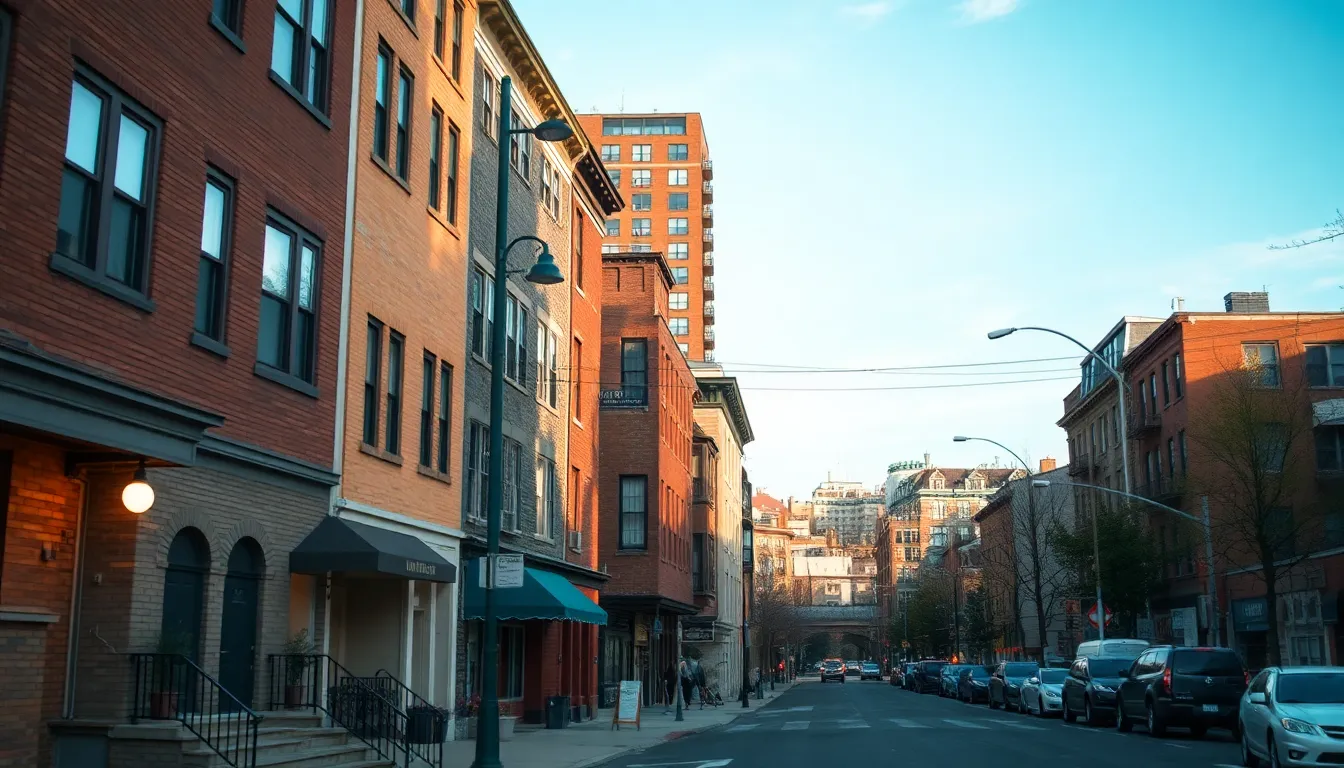Table of Contents
ToggleSchenectady, a city nestled in upstate New York, has gained a reputation for being one of the more dangerous places in the region. With rising crime rates and a series of high-profile incidents, residents and outsiders alike are left questioning what factors contribute to this perception. Understanding the roots of Schenectady’s challenges requires delving into its social, economic, and historical contexts.
As urban areas often face unique struggles, Schenectady’s situation reflects broader trends seen in many cities across the United States. From economic decline to issues with public safety, the complexities of this city’s landscape paint a vivid picture of the challenges it faces. Exploring these factors not only sheds light on Schenectady’s current state but also opens the door to discussions about potential solutions and community resilience.
Overview of Schenectady
Schenectady, located in eastern New York, presents a complex urban landscape marked by historical significance and current challenges. Once a thriving manufacturing center, the city has experienced economic shifts that contributed to increased crime rates. Crime statistics indicate a higher prevalence of violent offenses compared to national averages, furthering concerns among residents.
Population dynamics play a crucial role in Schenectady’s current situation. The city’s population has declined over recent decades, leading to vacant properties and diminished community resources. These conditions often correlate with higher crime levels, as social disorganization affects neighborhood safety.
Economic factors also contribute to Schenectady’s reputation. Job opportunities have dwindled, leading to increased poverty rates. Limited economic development hampers residents’ prospects, creating an environment where crime becomes a viable option for survival.
Various community and cultural initiatives aim to address these issues. Local organizations focus on promoting safety, economic revitalization, and community engagement. Collaborative efforts involving law enforcement, businesses, and residents seek to restore Schenectady’s image while enhancing the quality of life for its inhabitants.
Crime Statistics in Schenectady

Schenectady grapples with notable crime statistics that underscore its reputation for danger. Understanding both violent and property crime rates provides insight into the challenges facing the city.
Violent Crime Rates
Schenectady’s violent crime rates exceed national averages, raising concerns among residents and officials. According to the FBI’s Uniform Crime Reporting (UCR) Program, the city reported a violent crime rate of 977 incidents per 100,000 people in 2022. This figure is significantly higher than the national average of 388 incidents per 100,000 people. Key types of violent crimes include:
- Aggravated Assault: Accounts for approximately 60% of violent crimes, indicating severe attacks or threats.
- Robbery: Occurs at a rate of about 160 incidents per 100,000 residents.
- Homicides: Registered 9 murders in 2022, reflecting a concerning upward trend.
Property Crime Rates
Property crime in Schenectady also represents a significant issue. The city reported a property crime rate of 3,023 incidents per 100,000 people in 2022, well above the national average of 2,199 incidents per 100,000 people. Major categories of property crime include:
- Burglary: Contributes to about 25% of property crimes, occurring at a rate of approximately 500 incidents per 100,000 people.
- Theft: Represents the highest percentage, with around 2,000 theft incidents recorded.
- Motor Vehicle Theft: Accounts for about 130 incidents per 100,000 residents, indicating ongoing issues with vehicle security.
These statistics reflect the complex reality of life in Schenectady, emphasizing the need for targeted responses to address crime effectively.
Contributing Factors to Danger
Schenectady’s dangerous reputation stems from a mix of economic, social, and criminal dynamics that create a challenging environment for its residents. Understanding these contributing factors is crucial for grasping the complexities of crime in the city.
Economic Disparities
Economic disparities significantly affect Schenectady’s safety landscape. The city faces high poverty rates, with approximately 20% of the population living below the poverty line. These financial challenges lead to diminished access to education, healthcare, and employment opportunities. As job prospects decline, many residents resort to illegal activities as a means of survival. The loss of manufacturing jobs has further exacerbated these issues, creating a cycle where economic instability fuels crime and insecurity.
Drug Issues
Drug-related problems heavily influence crime rates in Schenectady. The opioid crisis has notably impacted the area, with overdose deaths rising sharply over recent years. In 2021, Schenectady County reported over 100 overdose fatalities, highlighting the urgent nature of the situation. Drug trafficking and distribution networks thrive in the city, contributing to violence as rival groups contend for control of lucrative markets. This interconnectedness between drug abuse and violent crime creates a hazardous atmosphere for residents.
Gang Activity
Gang activity remains a serious issue in Schenectady, intensifying the city’s crime rate. Various gangs operate within urban neighborhoods, engaging in drug trafficking, robbery, and violent confrontations. Reports indicate that gang-related incidents constitute a significant portion of violent crime, leading to heightened fear among residents. According to local law enforcement, gang violence disrupted community safety, recurrently manifesting in shootings and assaults. Targeted interventions aimed at reducing gang influence are essential for restoring stability and improving overall public safety in the city.
Community Response and Efforts
Schenectady’s community actively works to combat its challenges through various initiatives and law enforcement strategies. These efforts focus on fostering safety, economic revitalization, and enhanced quality of life.
Local Initiatives
Local organizations launch initiatives aimed at community engagement and crime prevention. Programs include neighborhood watch groups that educate residents, promote vigilance, and encourage communication with law enforcement. Community revitalization efforts address vacant properties by transforming them into affordable housing or resources like community gardens. Workshops and events focus on youth involvement, providing mentorship and opportunities that foster positive development. Collaboration between nonprofits, businesses, and community members bolsters local economy and safety while optimizing access to resources.
Law Enforcement Strategies
Law enforcement in Schenectady employs various strategies to address crime and enhance public safety. Community policing emphasizes building relationships between officers and residents, promoting trust and cooperation. Crime analytics tools help identify hotspots, facilitating targeted patrols and resource allocation. Additionally, specialized task forces tackle issues like drug trafficking and gang-related activities, disrupting criminal networks. Partnership with local organizations strengthens outreach programs, connecting individuals in need with vital social services. These integrated strategies aim to reduce crime rates and improve overall safety in Schenectady.
Comparison with Other Cities
Schenectady’s crime rates present stark contrasts when compared with other cities in New York and the broader United States. In 2022, Schenectady reported a violent crime rate of 977 incidents per 100,000 people. New York City, for comparison, had a violent crime rate of 445 incidents per 100,000 people, indicating Schenectady’s challenges are significantly heightened.
| City | Violent Crime Rate (Incidents per 100,000 people) | Property Crime Rate (Incidents per 100,000 people) |
|---|---|---|
| Schenectady, NY | 977 | 3,023 |
| New York City, NY | 445 | 1,855 |
| Albany, NY | 646 | 3,328 |
| Buffalo, NY | 1,164 | 3,126 |
| Rochester, NY | 1,257 | 3,301 |
Schenectady’s property crime rate also surpasses national averages. With 3,023 incidents per 100,000 people, it activates concerns about safety compared to Rochester’s 3,301 or Buffalo’s 3,126. Albany’s property crime rate stands at 3,328, highlighting the prevalence of crime in urban environments.
Factors influencing Schenectady’s dangerous reputation include socioeconomic status, population decline, and urban decay. While cities like New York and Albany face similar economic issues, they often benefit from larger resources and more diverse economies. For instance, New York City’s more robust job market and extensive social services may correlate with its lower crime rates.
Neighborhood dynamics also differ across cities. Community engagement initiatives in larger urban areas might directly affect crime reduction, while Schenectady continues to counter challenges from a declining population and higher poverty rates. Collaborative efforts among law enforcement and community organizations in Schenectady aim to create a more cohesive response against crime, though differing levels of success in various cities complicate the comparison.
Overall, Schenectady exemplifies urban struggles that mirror broader trends, yet its specific challenges mandate targeted responses distinct from those in other cities.
Schenectady’s challenges highlight the complex interplay of economic decline and social issues that contribute to its dangerous reputation. While crime rates remain a significant concern the city’s community is actively working towards revitalization and safety. Local initiatives and law enforcement strategies aim to address these pressing issues through collaboration and engagement.
Understanding the underlying factors driving crime in Schenectady is crucial for fostering meaningful change. It’s this collective effort that holds the potential to transform the city’s narrative and improve the quality of life for its residents. With perseverance and commitment the community can pave the way for a safer and more prosperous future.




